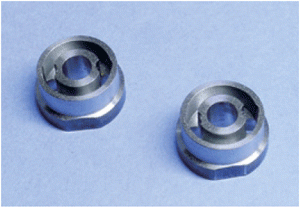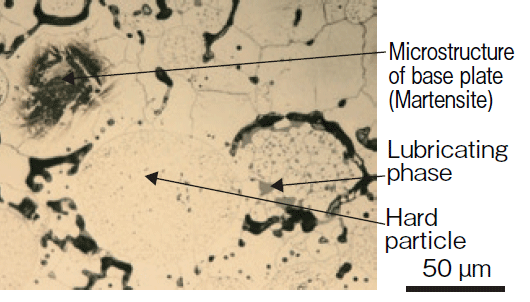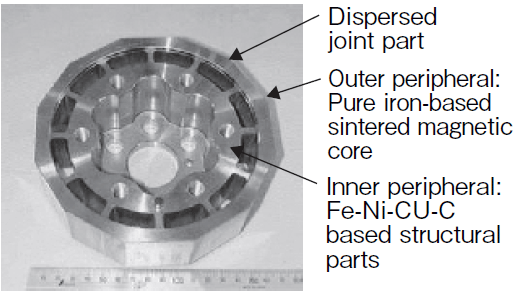Powder Metallurgy products in fuel efficient and environmentally friendly vehicles
The automotive sector and its suppliers are accordingly accelerating efforts to develop new technology and materials which will improve the fuel efficiency of internal combustion (IC) engines and thereby reduce greenhouse gas emissions, and they are continuing to make improvements also to hybrid (HV), electric vehicles (EV), and fuel cell vehicles (FCV).
Turbochargers
One way of improving overall fuel efficiency is by downsizing engines yet maintaining the equivalent power output of the larger engines they have replaced. In the case of turbochargers, downsizing requires the PM parts used in them to have increased wear resistance at higher operating temperatures.
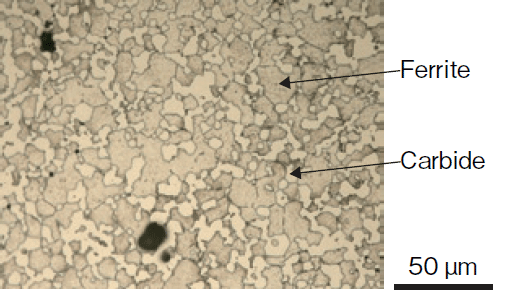
Fig.1 Microstructure of high Cr content sintered ‘EW-50’ material having high heat and wear resistance. (Courtesy Hitachi Chemical, Japan)
Hitachi Chemical met the challenge by developing a new steel-based sintered material with 20% Cr content designated ‘EW-50’. The Cr content is finely and uniformly dispersed in the matrix as Cr carbide (30% ratio area) (Fig.1), and the sintered material was found to have excellent wear and oxidation resistance even at temperatures of 700C or higher.
Ishii stated that Hitachi Chemical has also developed Cr containing PM steels to replace former Ni-PM steels to produce lighter or thinner walled automotive PM parts in order to save weight but without sacrificing strength.
Idling stop systems
Idling stop systems are increasingly being used to shut down the engine when the driving speed decreases to a certain level, and then restart the engine when the accelerator pedal is pressed.
The starter motor used in idling stop system must be more durable and less noisy than existing starter motors and Hitachi Chemical has developed a Cu-based sintered bearing material designated KCR-1 which contains a solid lubricant dispersed in the bearing. The solid lubricant reduces the friction coefficient of the sintered bearing and also reduces the squeals generated by the sliding surfaces.
Diesel engine fuel injector
Ishii reported that Hitachi Chemical has developed a stator core for a solenoid valve used in a common rail high speed, high precision fuel injector mechanism for diesel engines. The stator cores, made from soft magnetic composite iron powder, are used to open and close diesel fuel injection valves.
The fuel injector stator core (Fig.2) is produced by compacting the electrically insulated SMC iron powder and the resulting compacts have reduced iron loss (thermal loss) in the AC magnetic field. The SMC iron powder magnets do not require sintering.
Valve train parts for flexible fuel vehicles
Flexible fuel vehicle engines use bio-ethanol as a replacement for petrol and natural gas and offer cleaner combustion and hence cleaner emissions. However, the valve seats have a tendency to adhere and wear due to the high frequency of metal contact between the seat and the valve, and a suitably wear resistant valve seat material must be used.
Hitachi Chemical developed its EH-51H sintered valve seat material for Flexible fuel vehicles which showed improved anti-adhesion properties thanks to the combination of dispersed hard particles in the sintered matrix and the inclusion of an uniformly dispersed solid lubricant (Fig.3)
Ultra-high porosity parts for engine heat insulation
A number of thermal management materials have been introduced in recent years to improve the fuel efficiency of vehicles. Ishii reported that Hitachi Chemical had developed a 316L stainless steel porous metal with maximum porosity up to 95% which he stated exceeds all previous porosity levels achieved by the powder metallurgy route.
The porous metal is said to be characterised by a fine porous binary structure, the open-pore type with continuous coarse-scale pores and the closed-pore type with independent closed pores. The closed type porous stainless steels can be used to retain heat inside a combustion engine leading to highly efficient combustion.
Reactor core for in-car inverters
In the HV and EV sector Hitachi Chemical has developed a soft magnetic composite (SMC) iron powder reactor core used to increase voltage through the inverters in electric vehicles (Fig.4).
The reactor core combines high magnetic flux density and low hysteresis loss, and its surface is coated to give the SMC material great stability at high temperatures. The cores can be mounted not only in the inverters of HVs and EVs but can also be used in solar panels, hot water supply systems using heat pumps, and in wind turbines.
Thermoelectric regeneration of waste heat
Ishii also reported that Hitachi Chemical has developed thermoelectric conversion technology directly capable of converting thermal energy to electricity which the company anticipates being used for waste heat regeneration from automobiles as well as from industrial furnaces.
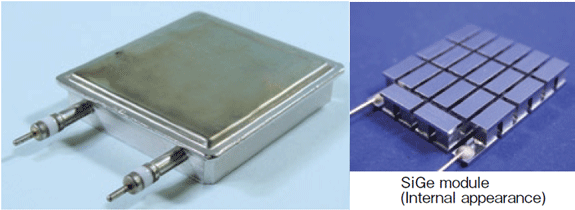
Fig.5 SiGe thermoelectric and encapsulated models used for waste heat regeneration. (Courtesy Hitachi Chemicas, Japan)
Ishii states that a Powder Metallurgy method is used to produce the thermoelectric modules from environmentally friendly materials such as SiGe, Mg2Si, and Mn1.8Si in which reduced thermal conductivity is achieved via micronization of crystals. By decompression-sealing the encapsulated modules, the thermal contact resistance between the module and contacting case can be reduced to an extent that underlines their potential use within high temperature and corrosive environments.
Reference:
[1] Kei Ishii, Trends in environmental and energy saving technology for automobiles and corresponding developments in Powder Metallurgy, published in Hitachi Chemicals Technical Report, Vol.55, 2013, pp50-53.
Download FREE PM Review magazine | News | Articles | Subscribe to e-newsletter



